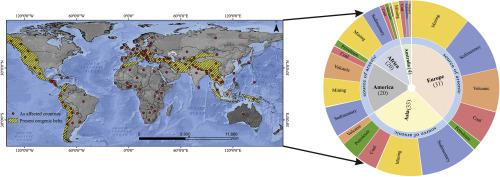Geoscience Frontiers ( IF 8.5 ) Pub Date : 2020-10-01 , DOI: 10.1016/j.gsf.2020.08.015 E. Shaji , M. Santosh , K.V. Sarath , Pranav Prakash , V. Deepchand , B.V. Divya

|
More than 2.5 billion people on the globe rely on groundwater for drinking and providing high-quality drinking water has become one of the major challenges of human society. Although groundwater is considered as safe, high concentrations of heavy metals like arsenic (As) can pose potential human health concerns and hazards. In this paper, we present an overview of the current scenario of arsenic contamination of groundwater in various countries across the globe with an emphasis on the Indian Peninsula. With several newly affected regions reported during the last decade, a significant increase has been observed in the global scenario of arsenic contamination. It is estimated that nearly 108 countries are affected by arsenic contamination in groundwater (with concentration beyond maximum permissible limit of 10 ppb recommended by the World Health Organization. The highest among these are from Asia (32) and Europe (31), followed by regions like Africa (20), North America (11), South America (9) and Australia (4). More than 230 million people worldwide, which include 180 million from Asia, are at risk of arsenic poisoning. Southeast Asian countries, Bangladesh, India, Pakistan, China, Nepal, Vietnam, Burma, Thailand and Cambodia, are the most affected. In India, 20 states and 4 Union Territories have so far been affected by arsenic contamination in groundwater. An attempt to evaluate the correlation between arsenic poisoning and aquifer type shows that the groundwater extracted from unconsolidated sedimentary aquifers, particularly those which are located within the younger orogenic belts of the world, are the worst affected. More than 90% of arsenic pollution is inferred to be geogenic. We infer that alluvial sediments are the major source for arsenic contamination in groundwater and we postulate a strong relation with plate tectonic processes, mountain building, erosion and sedimentation. Prolonged consumption of arsenic-contaminated groundwater results in severe health issues like skin, lung, kidney and bladder cancer; coronary heart disease; bronchiectasis; hyperkeratosis and arsenicosis. Since the major source of arsenic in groundwater is of geogenic origin, the extend of pollution is complexly linked with aquifer geometry and aquifer properties of a region. Therefore, remedial measures are to be designed based on the source mineral, climatological and hydrogeological scenario of the affected region. The corrective measures available include removing arsenic from groundwater using filters, exploring deeper or alternative aquifers, treatment of the aquifer itself, dilution method by artificial recharge to groundwater, conjunctive use, and installation of nano-filter, among other procedures. The vast majority of people affected by arsenic contamination in the Asian countries are the poor who live in rural areas and are not aware of the arsenic poisoning and treatment protocols. Therefore, creating awareness and providing proper medical care to these people remain as a great challenge. Very few policy actions have been taken at international level over the past decade to reduce arsenic contamination in drinking water, with the goal of preventing toxic impacts on human health. We recommend that that United Nations Environment Programme (UNEP) and WHO should take stock of the global arsenic poisoning situation and launch a global drive to create awareness among people/medical professionals/health workers/administrators on this global concern.
中文翻译:

地下水的砷污染:以印度半岛为重点的全球概要
全球有超过25亿人依靠地下水来饮用,提供高质量的饮用水已成为人类社会的主要挑战之一。尽管地下水被认为是安全的,但高浓度的重金属如砷(As)可能构成潜在的人类健康隐患和危害。在本文中,我们概述了全球范围内各个国家地下水砷污染的现状,重点是印度半岛。在过去十年中报告了几个新近受影响的地区,在全球砷污染的情况下,观察到显着增加。试图评估砷中毒与含水层类型之间的相关性的尝试表明,从未固结的沉积含水层(特别是位于世界上较年轻的造山带中的那些)抽取的地下水受到的影响最大。据推断,超过90%的砷污染是地质成因。我们推断冲积沉积物是地下水中砷污染的主要来源,并且我们推测其与板块构造过程,山区建筑,侵蚀和沉积有很强的关系。长期饮用受砷污染的地下水会导致严重的健康问题,例如皮肤,肺癌,肾癌和膀胱癌;冠状动脉心脏疾病; 支气管扩张 角化过度和砷中毒。由于地下水中砷的主要来源是地质成因,污染的扩展与一个地区的含水层几何形状和含水层特性有着复杂的联系。因此,应根据受影响地区的矿物来源,气候和水文地质情况设计补救措施。可用的纠正措施包括使用过滤器从地下水中除去砷,探究更深的或替代的含水层,对含水层本身的处理,通过人工补给地下水的稀释方法,联合使用以及安装纳米过滤器等方法。亚洲国家受砷污染影响的绝大多数人是生活在农村地区的贫困者,他们不了解砷中毒和治疗方案。因此,提高认识并为这些人提供适当的医疗服务仍然是一个巨大的挑战。在过去的十年中,国际上很少采取政策措施来减少饮用水中的砷污染,目的是防止对人体健康的毒害。我们建议联合国环境规划署(环境署)和世界卫生组织应盘算全球砷中毒情况,并发起一项全球运动,以提高人们/医学专业人员/卫生工作者/行政管理人员对这一全球关切的认识。











































 京公网安备 11010802027423号
京公网安备 11010802027423号